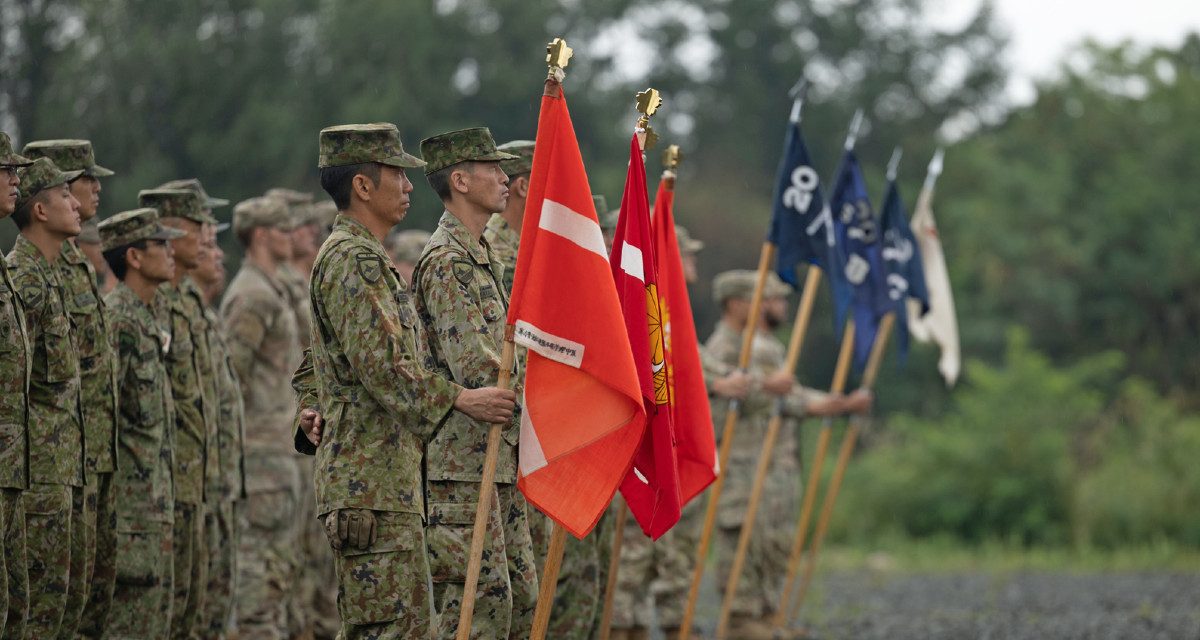In December 2022, the government of Japan, led by its National Security Council and the Diet, approved three strategic documents: the National Security Strategy, the National Defense Strategy, and the Defense Buildup Program. With this approval, the government vowed to create and reinforce the joint operational posture of its three Japan Self-Defense Force (JSDF) services. A permanent joint headquarters (PJHQ) will allow Japan to “build a system capable of seamlessly conducting cross-domain operations at all stages from peacetime to contingency, with the aim of strengthening the effectiveness of joint operations among each [J]SDF service.” Many of the significant changes within the strategic documents are driven by the transformed Indo-Pacific region’s operational environment—specifically, changes directly caused by the strategic orientation of the People’s Republic of China (PRC).
Japan’s Ministry of Defense confirmed that it will establish the new PJHQ by the end of its fiscal year 2024 (March 2025) and requested a budget for 240 members to initially staff it. The ministry also approved the PJHQ to be located at Ichigaya, Tokyo and revealed that a four-star general or flag officer—which is the same rank as the chiefs of staff of each of the three JSDF services—will command the PJHQ. The headquarters will primarily oversee the three services to prepare for any conceivable emergencies. A reading of the strategic documents makes clear that these changes reflect an appreciation on Japan’s part of, specifically, the dangers and implications of threatening PRC activities—including the prospect of an invasion of Taiwan.
For the past few years, Japan has fulfilled its pledge and created paths to strengthen its fundamental defense and develop counterstrike capabilities to solidify its national security objectives. These steps notwithstanding, the JSDF lacks organic integration within its three services to conduct complex and sustainable joint operations. The establishment of a PJHQ will fill this gap. Currently, the chief of staff of the Joint Staff, General Yoshihide Yoshida, is in charge of the entire JSDF. However, according to the Ministry of Defense, General Yoshida is not a commander, but an advisor who assists Defense Minister Minoru Kihara in his daily decision-making regarding the operation of the JSDF.
The creation of the joint commander position, then, will not only lessen the burden on General Yoshida but allow Japan’s top military officer to focus more on broader issues related to Japan’s overarching defense interests and objectives. Currently, General Yoshida receives orders from Defense Minister Kihara and instructs the three service chiefs on specific JSDF operations. What is more, General Yoshida advises Prime Minister Fumio Kishida and Defense Minister Kihara on how the JSDF should operate. Under the new framework provided in the three strategic documents, the joint commander will have the authority to command specific operations of JSDF units. The National Defense Strategy notes that “to reinforce effectiveness of joint operational posture, Japan will establish a permanent Joint Headquarters which can unify command of [the three services] by reviewing the existing organization.”
Establishing a PJHQ will allow its commander to centrally control the JSDF units in peacetime, national disaster emergencies, and wartime. A PJHQ will also bolster the ability to directly coordinate with US Indo-Pacific Command (USINDOPACOM). As chief of staff of the Joint Staff, General Yoshida’s US counterpart is General Charles Q. Brown, Jr., the chairman of the Joint Chiefs of Staff. This means Japan presently does not have a senior military official to directly engage with Admiral John Aquilino, the USINDOPACOM commander, on a routine basis. After March 2025, the joint commander will be the sole counterpart of the USINDOPACOM commander, resolving command-and-control synchronization concerns within joint and bilateral operations. A PJHQ will allow General Yoshida to consult with General Brown on shared military and national defense issues while letting the joint commander work with the USINDOPACOM commander on bilateral operations and responses between the JSDF and the US forces.
The plan to establish a PJHQ shows that Japan has taken necessary steps to properly respond to one of the most dangerous and complex security environments in the modern era. This also suggests that Japan recognizes the fluidity and fragility of the situation in the Indo-Pacific region, especially with the PRC’s continual aggressive tactics and presence in the Ryukyu Islands. Given that context, it is more important than ever to maintain strategic dialogue between Japan and the United States.
The 2023 National Defense Authorization Act ordered the US military to develop a new construct for operational command in the Western part of Indo-Pacific region. The concept is a joint force headquarters that can serve as an operational command to integrate “joint all domain command and control effects chains and mission command and control, including in conflicts that arise with minimal warning.” As Japan establishes its PJHQ and the US its own new joint headquarters in the region, there is a tremendous opportunity to further enhance integration for joint and bilateral operations—integration that will play a vital role in deterring future conflicts and other destabilizing activities by the PRC in the Ryukyu Islands or Taiwan.
Lieutenant Colonel Christopher Lee is an Indo-Pacific foreign area officer for US Army Japan. He holds an undergraduate degree from the United States Military Academy and graduate degrees from Columbia University and UCLA.
The views expressed are those of the author and do not reflect the official position of the United States Military Academy, Department of the Army, or Department of Defense.
Image credit: Sgt. 1st Class Mary Katzenberger, US Army Japan


